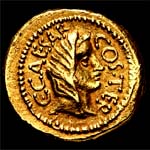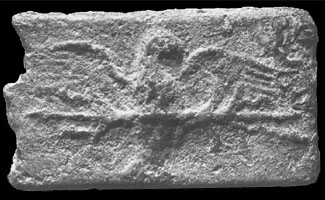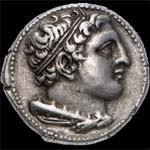
On the contrary of the coins currently used, the value of the ancient coins (and of course the Roman coins too) was related to the value of the metal with which they were minted; the coin, therefore, had an intrinsic value, depending on the weight and the type of material (i.e.: gold, silver, copper) used to mint them.
The values and the names of the ancient coins, therefore, often derived from the unities of weight used at that time. Moreover, the ratios of the values among the coins of a monetary system follow the relationships among the unities of measure of the contemporary system of weight.
In Rome the unity of weight was the libra (pound), which in turn derived from the Greek system of weights based on the drachma. The pound was the unity of weight used by all the italic peoples, with different values in the different geographical areas; the Adriatic pound, as an example, worthed 450 g, that Latin one 273g, and that Roman pound 327g.
In the following chart the system of multiples and fractions of the drachma and the pound:
| unity of weight | ratio with the drachma | weight in grams |
|---|---|---|
| chalcus | 1 / 48 | 71 mg |
| siliqua | 1 / 18 | 189 mg |
| obolus | 1 / 6 | 0,568 g |
| scruple | 1 / 3 | 1,136 g |
| drachma | 1 | 3,408 g |
| shekel | 2 | 6,816 g |
| ounce | 8 | 27,264 g |
| libra | 96 | 327,168 g |
| mine | 128 | 436,224 g |
As shown in the table, the Roman pound woth exactly three quarters of the Greek mine, the reference value for the Greek coins in gold.
The unities of weight could also be express then in terms of multiples of the ounce or fractions of the pound (equivalent to the as of the monetary system), as shown in the following table:
| unity of weight | ratio with the ounce | ratio with the as | weight in grams |
|---|---|---|---|
| ounce | 1 | 27,25 | |
| sescuncia | 1,5 | ||
| sextans | 2 | 1/6 | 54,5 |
| quadrans | 3 | 1/4 | 81,75 |
| triens | 4 | 1/3 | 109 |
| quincunx | 5 | ||
| semis | 6 | 1/2 | 163,5 |
| septunx | 7 | ||
| bes | 8 | 2/3 | |
| dodrans | 9 | ||
| dextans | 10 | ||
| deunx | 11 | ||
| as | 12 | 327 |
 Before
the usage of the coin in Rome, blocks of metal were initially used as form of
intermediation in the commercial exchanges like shapeless blocks (aes
rude).
Before
the usage of the coin in Rome, blocks of metal were initially used as form of
intermediation in the commercial exchanges like shapeless blocks (aes
rude).
In a following phase, the metal began to have exchanged as bronze ingots (aes signatum).
 With
the introduction of the coin, in its minting was used metals more or less
precious according to the required value:
With
the introduction of the coin, in its minting was used metals more or less
precious according to the required value:
The coins were initially melted and only in a second phase they began to be coined by minting. The images represented on the coins were mainly related to the Roman mythology.
The monetary system adopted during the Roman Republic was at the end organized according the following table:
| Metal | Coin | Ratio with the denarius | Ratio with the as | Ratio with the uncia | Mark |
|---|---|---|---|---|---|
| Gold | Aureus | 25 | |||
| Silver | Denarius | 1 | 10 | X | |
| Bronze | Decussis | 10 | X | ||
| Silver | Quinarius | 1/2 | |||
| Bronze | Quincussis | 5 | V | ||
| Quadrusse | 4 | ||||
| Tressis | 3 | ||||
| Silver | Sestertius | 1/4 | 2,5 | IIS or HS | |
| Bronze | Dupondius | 2 | |||
| As | 1 | 12 | I | ||
| Semis | 1/2 | 6 | S | ||
| Triens | 1/3 | 4 | four pellets | ||
| Quadrans | 1/4 | 3 | three pellets | ||
| Sextans | 1/6 | 2 | two pellets | ||
| Uncia | 1/12 | 1 | one pellet | ||
| Semi-uncia | 1/24 | 1/2 | Σ |
 The
evolution from the coins in bronze toward more precious monetary systems as
the ones based on the silver was greatly influenced by the contact of the
Roman civilization with the colonies of the Magna Graecia, where silver coins
were used, following the scheme of the Greek monetary system:
The
evolution from the coins in bronze toward more precious monetary systems as
the ones based on the silver was greatly influenced by the contact of the
Roman civilization with the colonies of the Magna Graecia, where silver coins
were used, following the scheme of the Greek monetary system:
 With
the progress of the organization of the government and with the political
struggles for the power, also the coins began to be used as means of
communication and propaganda.
With
the progress of the organization of the government and with the political
struggles for the power, also the coins began to be used as means of
communication and propaganda.
The moneyers in particular, who were the officials taking care of the minting of the coins, began to publicize on the coins the prestige of their own family (gens), producing an extreme variability of coined types.
With the advent of Julius Caesar began the representation of people on the principal face of the coins.